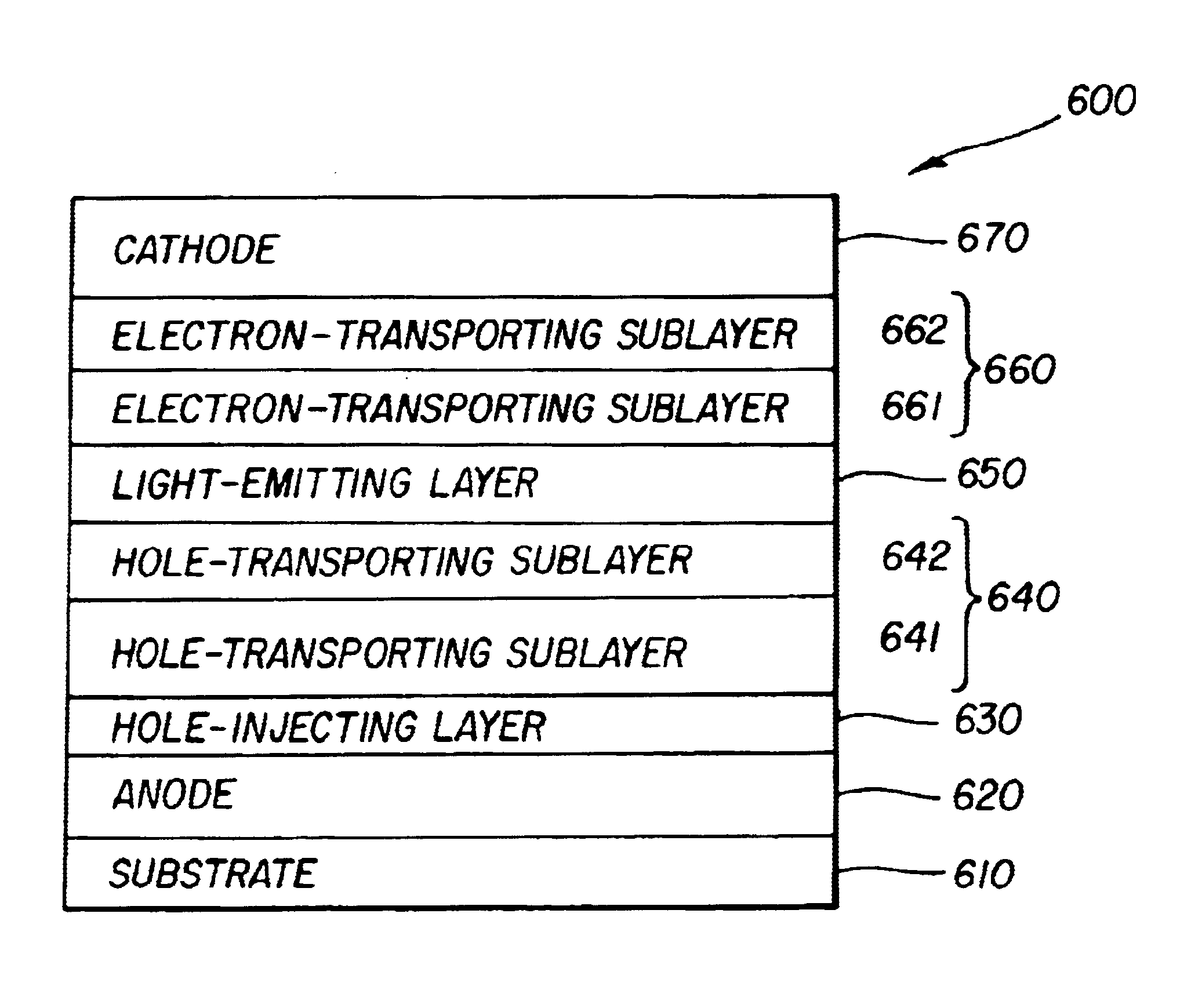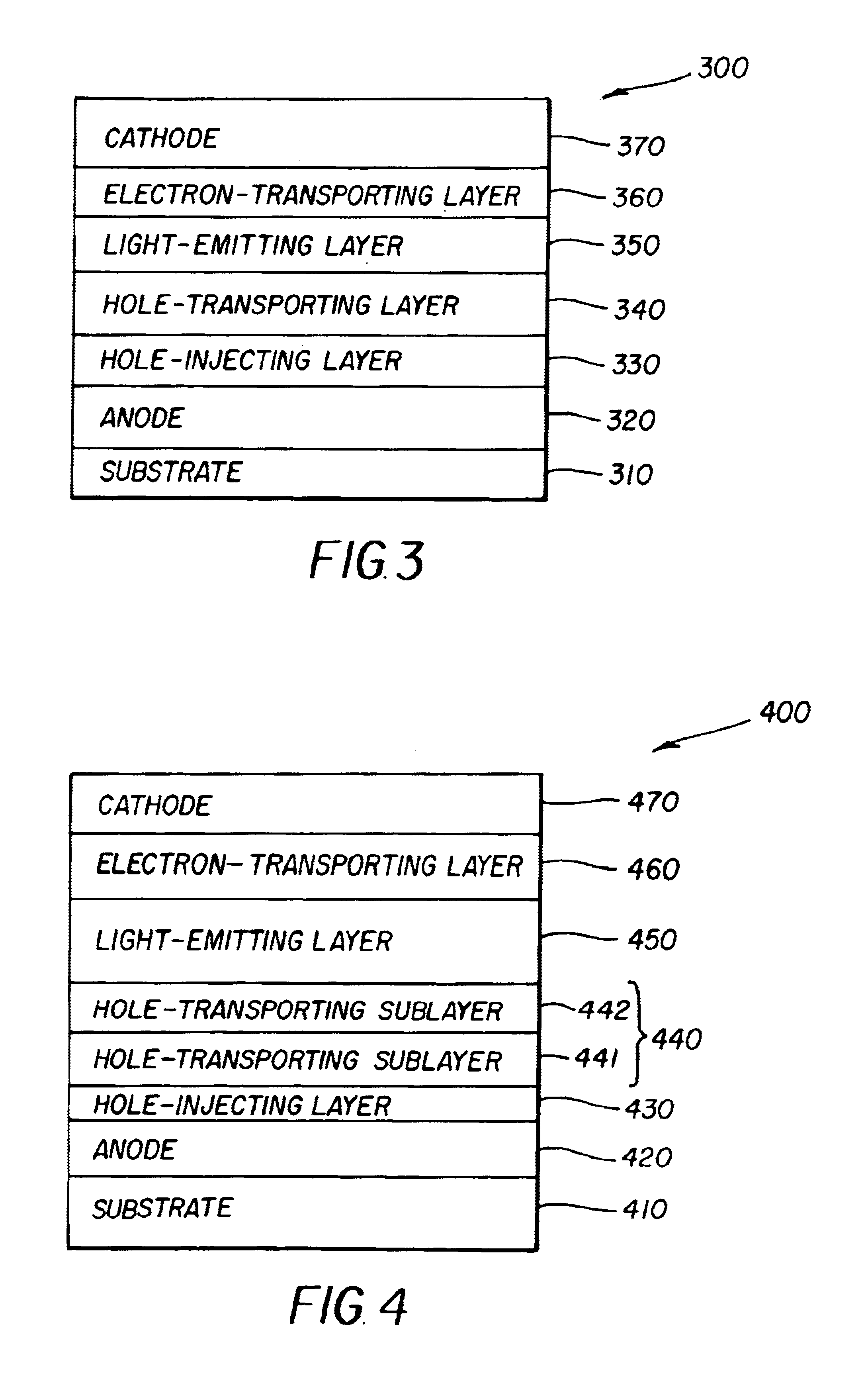White light-emitting device with improved doping
a technology of light-emitting devices and diodes, which is applied in the direction of discharge tubes luminescnet screens, other domestic articles, natural mineral layered products, etc., can solve the problems of difficult control, low intensity of red components of emission spectrum, and only about 30% of original white light, etc., to improve the color purity of red components, improve the intensity of red components, and reduce the power requirement of red pixels
- Summary
- Abstract
- Description
- Claims
- Application Information
AI Technical Summary
Benefits of technology
Problems solved by technology
Method used
Image
Examples
examples 2-4
The OLEDs of Examples 2-4 were constructed similarly to that of Comparative Example 1, except that the HTL was codoped with 2% of rubrene and with DCJTB as a red dopant, the percentages being indicated in Table 1a. Also reported in Table Ia is the performance of the devices at a current density of 20 mA / cm2 in terms of drive voltage and photometric parameters (luminous yield and CIE coordinates) with no color filter. The same photometric parameters are reported in Table Ib for each OLED with a red, green, or blue color filter.
TABLE IaComposition and performance parameters of the OLEDsof Examples 1-4 without color filters and at a currentdensity of 20 mA / cm2Column 2 indicates the percentage of the red dopant,DCJTB, in the hole-transporting layer; Column 3reports the drive voltage; Column 4 reports theluminous yield; and Column 5 reports the CIE coordinates%VdriveYieldCIEx,ExampleDCJTB(V)(cd / A)CIEy106.74.00.34, 0.4120.16.84.30.37, 0.4430.256.94.50.39, 0.4640.56.84.60.41, 0.47
TABLE Ib...
examples 5-9
The OLEDs of Examples 6 to 9 were prepared following the structure of OLED 400 as shown in FIG. 4. The hole-transporting layer included a 130 nm thick sublayer of undoped NPB (441) and a 20 nm thick sublayer (442) of NPB codoped with 2% of rubrene as a yellow dopant and various percentages of DCJTB as a red dopant. The blue light-emitting layer (450) was a 25 nm thick layer of TBADN as host doped with 5% BDTAPVB as a blue dopant. The electron-transporting layer (460) was 35 nm of Alq. The OLED of Comparative Example 5 was similar, except that sublayer 442 contained no DCJTB. With respect to the substrate (410), anode (420), hole-injection layer (430), and cathode (470), the OLEDs of Examples 5-9 were the same as for the OLED of Comparative Example 1.
Tables IIa and IIb indicate the percentages of DCJTB and the performance of these devices at 20 mA / cm2. Included is the power consumption of the simulated display panel operated at the D60 white point. The luminous yield without a filter...
examples 10-13
The OLEDs of Comparative Example 10 and Examples 11 to 13 had the structure shown in FIG. 3 and were prepared similarly to the devices of Examples 1 to 4 except that the red dopant was TPDBP instead of DCJTB.
Tables IIIa and IIIb indicate the percentages of TPDBP and the performance of these devices. The effects of the presence of TPDBP as a red dopant were similar to those of DCJTB in Examples 5-9, except that the drive voltage increased, by less than 1 volt, as the percentage of the red dopant increased. However, and most importantly, the luminous yield with the red filter increased by approximately a factor of 1.8 while the color approached a more saturated red. The improvements in efficiency and color of Examples 11-13 relative to Comparative Example 10 illustrate the advantage of using a codoped hole-transporting layer according to the present invention.
The EL spectra of the devices of Examples 10-13 are shown in FIG. 8. In that Figure, the arrows and numerals again indicate the...
PUM
| Property | Measurement | Unit |
|---|---|---|
| current density | aaaaa | aaaaa |
| current density | aaaaa | aaaaa |
| thickness | aaaaa | aaaaa |
Abstract
Description
Claims
Application Information
 Login to View More
Login to View More - R&D
- Intellectual Property
- Life Sciences
- Materials
- Tech Scout
- Unparalleled Data Quality
- Higher Quality Content
- 60% Fewer Hallucinations
Browse by: Latest US Patents, China's latest patents, Technical Efficacy Thesaurus, Application Domain, Technology Topic, Popular Technical Reports.
© 2025 PatSnap. All rights reserved.Legal|Privacy policy|Modern Slavery Act Transparency Statement|Sitemap|About US| Contact US: help@patsnap.com



